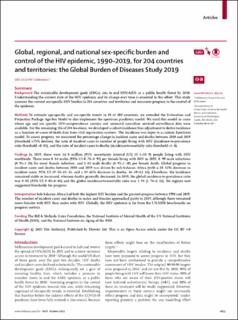| dc.contributor.author | Jahagirdar, Deepa | |
| dc.contributor.author | Walters, Magdalene K | |
| dc.contributor.author | Novotney, Amanda | |
| dc.contributor.author | Brewer, Edmond D | |
| dc.contributor.author | Frank, Tahvi D | |
| dc.contributor.author | Kisa, Adnan | |
| dc.contributor.author | Carter, Austin | |
| dc.contributor.author | Biehl, Molly H. | |
| dc.contributor.author | Hay, Simon I. | |
| dc.contributor.author | Kisa, Sezer | |
| dc.contributor.author | Murray, Christopher J L | |
| dc.contributor.author | Kyu, Hmwe H. | |
| dc.contributor.author | HIV Collaborators, GBD 2019 | |
| dc.date.accessioned | 2022-01-20T11:58:31Z | |
| dc.date.available | 2022-01-20T11:58:31Z | |
| dc.date.created | 2021-09-28T13:50:18Z | |
| dc.date.issued | 2021-09-27 | |
| dc.identifier.citation | The Lancet HIV. 2021, . | en_US |
| dc.identifier.issn | 2405-4704 | |
| dc.identifier.issn | 2352-3018 | |
| dc.identifier.uri | https://hdl.handle.net/11250/2838463 | |
| dc.description.abstract | Background: The sustainable development goals (SDGs) aim to end HIV/AIDS as a public health threat by 2030. Understanding the current state of the HIV epidemic and its change over time is essential to this effort. This study assesses the current sex-specific HIV burden in 204 countries and territories and measures progress in the control of the epidemic.
Methods: To estimate age-specific and sex-specific trends in 48 of 204 countries, we extended the Estimation and Projection Package Age-Sex Model to also implement the spectrum paediatric model. We used this model in cases where age and sex specific HIV-seroprevalence surveys and antenatal care-clinic sentinel surveillance data were available. For the remaining 156 of 204 locations, we developed a cohort-incidence bias adjustment to derive incidence as a function of cause-of-death data from vital registration systems. The incidence was input to a custom Spectrum model. To assess progress, we measured the percentage change in incident cases and deaths between 2010 and 2019 (threshold >75% decline), the ratio of incident cases to number of people living with HIV (incidence-to-prevalence ratio threshold <0·03), and the ratio of incident cases to deaths (incidence-to-mortality ratio threshold <1·0).
Findings: In 2019, there were 36·8 million (95% uncertainty interval [UI] 35·1–38·9) people living with HIV worldwide. There were 0·84 males (95% UI 0·78–0·91) per female living with HIV in 2019, 0·99 male infections (0·91–1·10) for every female infection, and 1·02 male deaths (0·95–1·10) per female death. Global progress in incident cases and deaths between 2010 and 2019 was driven by sub-Saharan Africa (with a 28·52% decrease in incident cases, 95% UI 19·58–35·43, and a 39·66% decrease in deaths, 36·49–42·36). Elsewhere, the incidence remained stable or increased, whereas deaths generally decreased. In 2019, the global incidence-to-prevalence ratio was 0·05 (95% UI 0·05–0·06) and the global incidence-to-mortality ratio was 1·94 (1·76–2·12). No regions met suggested thresholds for progress.
Interpretation: Sub-Saharan Africa had both the highest HIV burden and the greatest progress between 1990 and 2019. The number of incident cases and deaths in males and females approached parity in 2019, although there remained more females with HIV than males with HIV. Globally, the HIV epidemic is far from the UNAIDS benchmarks on progress metrics. | en_US |
| dc.description.sponsorship | Funding was provided by The Bill & Melinda Gates Foundation, the National Institute of Mental Health of the US National Institutes
of Health (NIH), and the National Institute on Aging of the NIH. | en_US |
| dc.language.iso | eng | en_US |
| dc.publisher | Elsevier | en_US |
| dc.relation.ispartofseries | The Lancet HIV;Volume 8, Issue 10 | |
| dc.rights | Navngivelse 4.0 Internasjonal | * |
| dc.rights.uri | http://creativecommons.org/licenses/by/4.0/deed.no | * |
| dc.subject | Sex-specific burdens | en_US |
| dc.subject | HIV | en_US |
| dc.subject | Development goals | en_US |
| dc.subject | Epidemic control | en_US |
| dc.subject | AIDS | en_US |
| dc.subject | Mortality | en_US |
| dc.title | Global, regional, and national sex-specific burden and control of the HIV epidemic, 1990–2019, for 204 countries and territories: the Global Burden of Diseases Study 2019 | en_US |
| dc.type | Peer reviewed | en_US |
| dc.type | Journal article | en_US |
| dc.description.version | publishedVersion | en_US |
| dc.rights.holder | © 2021 The Author(s). | en_US |
| cristin.ispublished | true | |
| cristin.fulltext | original | |
| cristin.qualitycode | 2 | |
| dc.identifier.doi | https://doi.org/10.1016/S2352-3018(21)00152-1 | |
| dc.identifier.cristin | 1939828 | |
| dc.source.journal | The Lancet HIV | en_US |
| dc.source.volume | 8 | en_US |
| dc.source.issue | 10 | en_US |
| dc.source.pagenumber | 633-651 | en_US |

